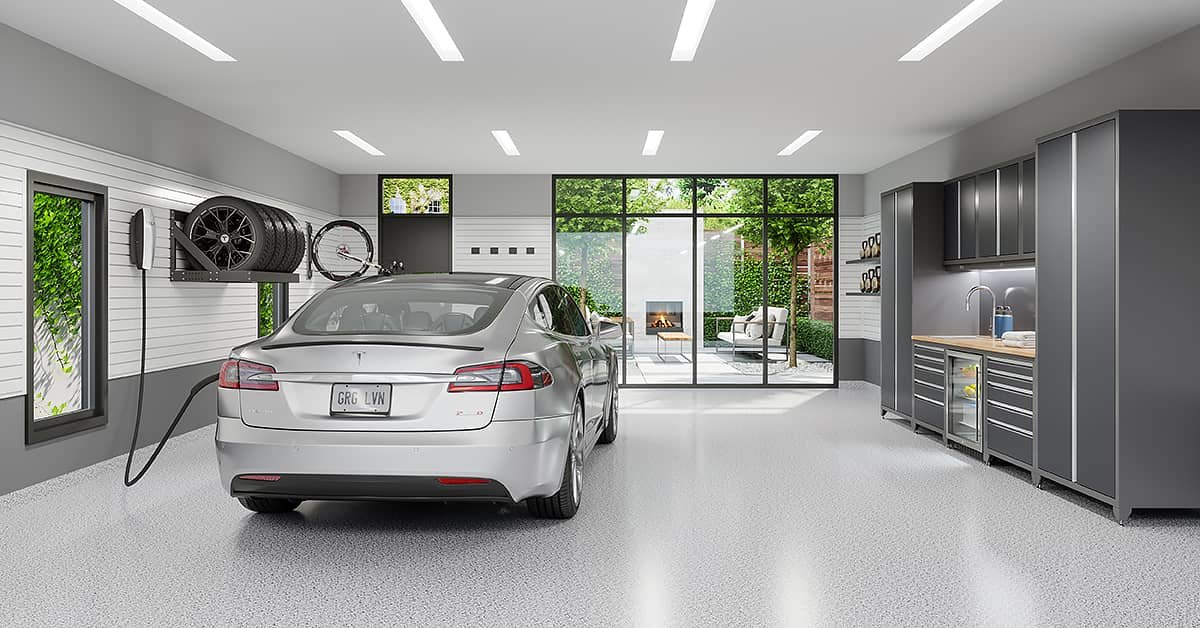High-end homeowners are outfitting their garages with heavy-duty outlets, solar panels and battery walls

When Peter Van Deerlin got his first electric vehicle in 2012, the now-57-year-old doctor wanted to be able to charge his car quickly enough to get to the hospital for middle-of-the-night emergencies.
He chose a Tesla Model S with a dual charger inside the car (a feature that the car maker later dropped) and installed a 100-amp electrical line in his garage in Moorestown, N.J.
The 100-amp line—the standard household outlet is 15 or 20 amps—served the couple well, said his wife, Vivianna Van Deerlin, 57, also a doctor. They have since expanded their fleet of electric vehicles, which now includes a Tesla Model 3, Model S and Roadster.
Around 2016, the Van Deerlins added a second Tesla wall connector and a NEMA 1450 outlet, which can be used to charge any electric vehicle. They also amped up the decor in their garage so that it would be “suitably nice” for the cars, said Vivianna Van Deerlin. She said they spent around $13,000 for Tesla-colored paint, a wall-mounted metal logo and decorative floor tiles.
President of a local club for Tesla owners, Vivianna Van Deerlin said she was an early adopter of driving electric for environmental reasons but fell in love with the car. “I love that driving electric doesn’t need to be a compromise,” she said. 
As more luxury car makers roll out electric vehicles, homeowners are building or retrofitting garages to equip them with powerful charging stations. Options range from installing a simple, 220- or 240-volt outlet to devising elaborate systems that incorporate solar panels and battery walls.
Entrepreneur and investor Rich Levandov, 67, and his wife, Robin Levandov, 65, a painter, are opting for the latter at their home in Sausalito, Calif. The couple, who split their time between Belmont, Mass., and Sausalito, have a simple 220-volt outlet and charger in Massachusetts. In California, they are installing Tesla roof tiles and a Tesla Powerwall, a series of roughly 2-foot by 4-foot batteries. The roof tiles will power the home and charge Mr. Levandov’s Tesla Model Y and four e-bikes, he said.
Electric vehicles make up roughly 3% of U.S. car sales, according to Pew Research. In August, President Biden signed an executive order calling for 50% of car and truck sales to be electric, hydrogen fuel cell or plug-in hybrids by 2030. Some of the pushback by consumers against e-vehicles is their price and the availability of charging infrastructure.
In North America, all electric cars can be charged using a standard J1772 plug, sometimes called a “J” plug, said Tom Moloughney, an electric-vehicle industry consultant. Teslas can be charged using a J plug but they need an adapter, which comes free with the vehicle. The amount of power a car gets during charging, measured in kilowatts, is a product of the outlet’s amperage, or the volume of electrons present, multiplied by voltage, which is the pressure of the electrical current, Mr. Moloughney explained. Standard household outlets are 120 volts with 15 or 20 amps, which is known as Level 1 charging, according to Mr. Moloughney. That translates to 3 to 5 miles of range per hour of charging, he said.
Level 2 charging uses a 240-volt circuit and cars can be charged at amperages ranging from 16 to 80, depending on the car. “Every electric vehicle can accept different levels of power,” Mr. Moloughney said. “So you match the charger to what your car can accept.” A car that charges at 80 amps on a 240-volt circuit can take 19.2 kilowatts an hour, he said. That translates to 50 to 60 miles of range per hour, roughly 10 to 20 times as fast as a Level 1 charging setup.
While it is common for homeowners to upgrade to 240-volt outlets, wall-mounted charging stations deliver a more powerful and faster charge. The cost of upgrading is typically several thousand dollars, including labor and a few hundred dollars for the charging station itself.
In addition to brand-specific charging stations, dozens of companies sell brand-agnostic systems. One is ChargePoint, which sells charging stations that can work with all electric vehicles on the market, said Colleen Jansen, the company’s chief marketing officer. “Maybe you have a Tesla today and you want a Polestar tomorrow,” she said. “You don’t have to worry about getting locked into any one brand.”
Colin Morales, a 58-year-old executive at a medical device company, has three ChargePoint stations, two at his primary residence in Carson City, Nev., and another at a home in San Jose, Calif. He has ordered a fourth for another home in Lake Tahoe, Calif.
at a home in San Jose, Calif. He has ordered a fourth for another home in Lake Tahoe, Calif.
Mr. Morales said he ordered the ChargePoint stations shortly after his partner, Stephanie Macauley, 56, who is retired, traded in her Porsche for a hybrid Range Rover. The thrill of greater fuel efficiency, and of helping the environment, was short-lived as the couple found themselves running all over town searching for a charging station.
Mr. Morales, who drives a Porsche Taycan and has a Ford F-150 truck, said he has plugged the cars into a 15-amp socket at night, only to wake up and find the vehicle 10% charged. “It would literally take three days if you’re on empty,” he said.
In Carson City, where Mr. Morales owns a custom, 5,500-square-foot house, he said he had his contractor install the two charging stations in an oversize, three-bay garage. Both stations are hard-wired into 220-volt outlets, but one is a 50-amp station and one is a 60-amp station. “It charges just a little bit faster,” he said. He estimated the Range Rover takes about 2½ hours to fully charge, and the Taycan takes between 6 and 7 hours if the car is on empty. The Taycan has around 220 miles of range, and the Range Rover has 50 miles of range using electricity plus another 400 miles using gas.
Mr. Morales said installation was more complicated at his home in San Jose, where his electrician ran wires under the house, between the breaker box and the garage. “I didn’t want the wire to show,” said Mr. Morales, who preferred to charge inside the garage. “I didn’t want this bulky charging thing outside my house,” he said.
Mr. Morales said he spent around $2,000 to install each charging station, including the electrical work. He estimated he is saving hundreds of dollars a month in gas. In San Jose, for example, Mr. Morales said his monthly electric bill has gone up roughly $50 per month since he installed the charging station. By comparison, he said he easily spent $200 a month on gas before switching to electric.
Article by: E.B. Solomont, Photo 1 by Waldemar Brandt on Unsplash, Photo 2 by Garage Living, Photo 3 by ChargePoint

Leave A Comment